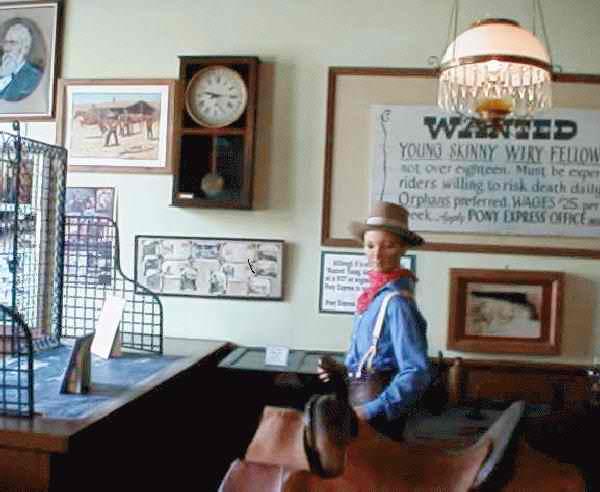
Children in History: Pony Express Riders (1860-61)

Figure 1.--This exhibit from the Pony Express Museum and the Hotel Museum in St. Joseph, Missouri recreates a scene of a Pony Express rider collecting the mail from the head office. Notice the sign on the wall, "WANTED: Young skinny wiry fellow not over eighteen. Must be experienced riders willing to risk death daily. Orphans preferred. Wages $25 ..." Image courtesy of William Ferguson.
|
|
The Pony Express is one of the mosted fabled feats in the history of the American West. In actuality the Pony Express mail service only operated for a brief period from April 1860 to November 1861. Previously letters from the eastern states mostly reached Califonia by long sea voyages around Cape Horn which took weeks in the best of circumstances. The Pony Express, operated by the Central
Overland California and Pikes Peak Express Company, to deliver mail and news between St. Joseph, Missouri, and San Francisco, California. The mail was delivered in relay, not unlike modern relay races, only mail and newspapers rather than batons were passed on. The Pony Express ran day and night, both in the summer and winter. A fresh horse and rider were waiting at each station to take the mail on to next station. Most of the riders were teenage boys. One rider was 11 years old. An ad for Pony Express riders read, "Wanted. Young, skinny, wiry fellows. Not over 18. Must be expert riders. Willing to risk death daily. Orphans preferred." The reason boys were preferred was that they did not weigh as much as adult riders and the horses could thus sustain faster speeds, the same reason that jockeys in horse raising have to be small. The Pony Express was a very popular service. In ended after only a year and a half because of the invention of the telegraph. Even fast ponies could not compete with the wires.
Chronology
The Pony Express is one of the most fabled episodes in the history of the American West. In actuality the Pony Express mail service only operated for a brief period from April 1860 to November 1861. It was trouble with the Paiutes that played a role in launching the Pony Express. In the end it failed because the Government did not award a mail contract. The Pony Express was fast, but there was no way it could compete with the telegraph once the lines were in place.
Mail
Previously letters from the eastern states mostly reached Califonia by long sea voyages around Cape Horn which took weeks in the best of circumstances.
The Route
The Pony Express, operated by the Central
Overland California and Pikes Peak Express Company, to deliver mail and news between St. Joseph, Missouri, and San Francisco, California.
The System
The American Pony Express was a vast under taking. The mail was delivered in relay, not unlike modern relay races, only mail and newspapers rather than batons were passed on. The Pony Express ran day and night, both in the summer and winter. A fresh horse and rider were waiting at each station to take the mail on to next station. The the gallent Express riders braved storms, indians, and other challenges to get the mail through.
Most of the Pony Express riders were teenage boys. They had to be because weight was all imortant. One rider was 11 years old. That was unusual. almost all of the riders were teenagers, and not older teens. An ad for Pony Express riders read, "Wanted. Young, skinny, wiry fellows. Not over 18. Must be expert riders. Willing to risk death daily. Orphans preferred." That was notbaann ad that would attract many responses today. At the time, many youth signed up. The work was exciting and the pay good. The reason boys were preferred was that they did not weigh as much as adult riders and the horses could thus sustain faster speeds, the same reason that jockeys in horse raising have to be small. An adult man would have tired out the horses. Slender youth mean that that the horses could gallop at full speed to the next station. The boys faced Native Americans, expert horsemen themselves, drought, and blizzard. Quute a few riders were lost. But most survived, many of which then enlisted to fight in the Civil War.
The Telegraph
The Pony Express was a very popular service. In ended after only a year and a half because of the invention of the telegraph. Even fast ponies could not compete with the wires. Of course the wires had to be strung. If the wires were cut you could not send or
recieve morse messages. There were bottle necks cause you could only send one message at once. It was not soon, however, before the telegraph dominated communication in America and eventually cables were layed across the Atlantic.
Movies
The Pony Express has been featured in several movies. I think one film was called "Young Riders". I recall seeing a poster at the Petee House Museum advertising this film. However using the Yahoo Movie base this title is not listed. A 1970's film is listed called "Pony Express Rider". It it about a young boy who joins the Pony Express to track down the killers of his father. Other titles about the Pony Express are all films of the 1930s.
HBC

Navigate the Boys' Historical Clothing Web Site:
[Return to the Main 19th century children in history page]
[Introduction]
[Activities]
[Biographies]
[Chronology]
[Clothing styles]
[Countries]
[Topics]
[Bibliographies]
[Contributions]
[FAQs]
[Glossaries]
[Images]
[Links]
[Registration]
[Tools]
[Boys' Clothing Home]
Created: March 18, 2003
Last updated: 3:43 AM 11/16/2013



